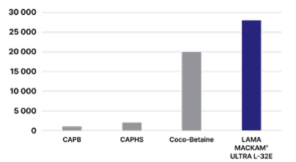Enhanced TDS
Identification & Functionality
- Agrochemical Functions
- CASE Ingredients Functions
- Chemical Family
- Chemical Name
- Cosmetic Ingredients Functions
- Country of Origin
- Plastics & Elastomers Functions
- Product Code
- MITM12107
- Technologies
- Product Families
Features & Benefits
- CASE Ingredients Features
- Labeling Claims
Applications & Uses
- Adhesive & Sealant End Applications
- Coating End Applications
- Compatible Polymers & Resins
- Personal Hygiene Applications
- Markets
- Applications
- Product Applications
K-FLEX® DP is useful in a wide variety of applications including:
- Latex adhesives
- Latex caulks and sealants
- Sealants
- Coatings
- Plastisols
- Melt compounded flexible vinyl compositions
K-FLEX® DP is an excellent choice for applications requiring a high solvating plasticizer. In addition, K-FLEX® DP can be used as a plasticizer in U.S. food packaging adhesives in accordance with the applicable regulations. Unlike other common dibenzoate products, K-FLEX® DP does not crystallize, making it a sound choice for facilities without heated storage.
Application Description Putty Effective low VOC plasticizer used in putty Water-based Latex Adhesives Effective plasticizer for water-based latex adhesives Crop Protection Highly recommended, low VOC adjuvant used in pesticides Lacquers - Nitrocellulose & Acrylic Highly recommended, low VOC coalescent for nitrocellulosic and acrylic lacquers Personal Care Plasticizer used as viscosity control aid in wax-based hair removal products Polysulfide Sealants Effective, low VOC plasticizer for polysulfide sealants Water-based Latex Caulks & Sealants Effective, low VOC plasticizer for water-based latex caulks and sealants Plastisol Printing Highly recommended, low VOC plasticizer used in plastisol printing
Properties
- Physical Form
Technical Details & Test Data
- Viscosity vs Temperature Graph

Packaging & Availability
- Packaging Type
Principal Information
- Group Principal Number
- S000008
- Principal
Storage & Handling
- Storage Conditions
- This product is stable and is not considered corrosive for metals and glass. The organic products of combustion are carbon oxides and water.
- This product should be stored away from excessive heat, sources of ignition and reactive materials. Limit indoor storage to areas equipped with an appropriate sprinkler system.
- Typical storage systems keep this product at approximately 86-100°F (30-38°C) and atmospheric pressure. If the moisture content of the ester is critical, the tank should be padded with nitrogen or vented to the atmosphere through a desiccant dryer. An over pressure/vacuum relief device should be provided for the tank.
- K-FLEX DP does not have a simple freeze point, instead forming a glass at very low temperatures. It can become very viscous at low temperatures, so it is therefore recommended that storage tanks be heated and insulated and that pumps and transfer piping also be heat-traced and insulated.
Bulk Tank: K-FLEX® plasticizers may be stored in type 304 stainless steel insulated and heated tanks. Storage tanks should be nitrogen padded to reduce discoloration of the product. Heat traced, type 304 stainless steel pipe and valves should also be used.
275 Gallon (Intermediate Bulk Container) Tote: The tote should be kept in a warm location >70°F (21°C) to prevent material from becoming too viscous and difficult to remove from the tote bin. If the material becomes too viscous or partially frozen, totes may be heated using heating blankets/jackets or a hot box to melt the material. Special attention must be taken to insure that the tote is completely sealed against moisture and oxygen/air during heating.
Other
- Appearance
- Clear colorless to pale yellow liquid
- Color (SDS)
- Clear colorless to light yellow
- Explosive Nature (SDS)
- Not explosive
- Insoluble in (SDS)
- Water
- Item Number
- Odor
- Ester like odor
- Odor (SDS)
- Slightly aromatic
- Other Hazards
- None known
- Oxidizing Properties (SDS)
- Non oxidising
- Temperature Control
- No
- USA/DOT UN Number
- Not Applicable
- Chemical Properties
Value Units Test Method / Conditions Assay min. 98.0 % % as benzoate ester Total Acidity max. 0.1 % % Benzoic Acid - Material Composition
Value Units Test Method / Conditions Volatile Organic Compounds (VOC) 3.2 % % ASTM D2369 - Optical Properties
Value Units Test Method / Conditions Color Scale max. 100.0 APHA APHA Refractive Index 1.5238 - at 25°C - Physical Properties
Value Units Test Method / Conditions Boiling Point 195.0 °C °C Boiling Point min. 350.0 °C °C at 750mmHg Density 9.3 lb/gal lb/gal ASTM D1475 at 25°C Flash Point 204.0 °C °C ASTM D92 Glass Transition Temperature (Tg) -51.0 °C °C Differential Scanning Calorimetry Kinematic Viscosity 89.0 cSt cSt at 25°C Moisture Content 0.02 % % Solidification Point -31.0 °C °C Solubility in Water 0.2 % % in water Specific Gravity 1.14 - at 25/25°C Surface Tension 42.8 dyn/cm dyn/cm ASTM D1331 Viscosity 99.0 cPs cPs Brookfield Viscometer at 25°C, 20 Rpm - SDS Physical and Chemical Properties
Value Units Test Method / Conditions Boiling Point (SDS) min. 350.0 °C °C At 1013.25 Hpa Density (SDS) 1.11 g/cm³ g/cm³ at 68°F Flash Point (SDS) 204.0 °C °C ASTM D92 Kinematic Viscosity (SDS) min. 89.0 mm²/s mm²/s At 77°F Kinematic Viscosity (SDS) max. 35.0 mm²/s mm²/s At 104°F Log Partition Coefficient (Log Pow) (SDS) 3.9 - log Pow, Octanol Water Melting Point (SDS) max. -20.0 °C °C At 1013.25 Hpa Relative Density (SDS) 1.11 - Relative Vapor Density (SDS) 11.8 - air =1 Surface Tension (SDS) 42.8 mN/m mN/m at 77°F Vapor Pressure (SDS) 0.0000034 hPa hPa at 77°F, extrapolated - Shelf Life & Stability
Value Units Test Method / Conditions Shelf Life 730.0 d d
